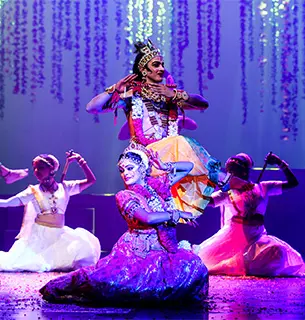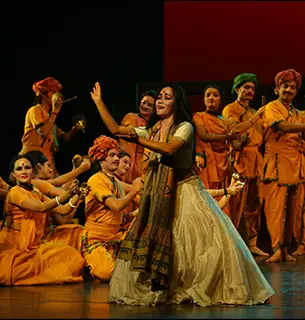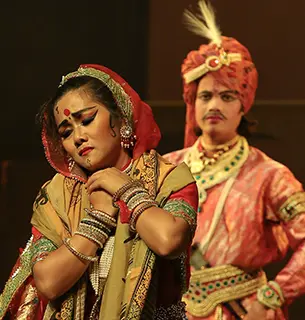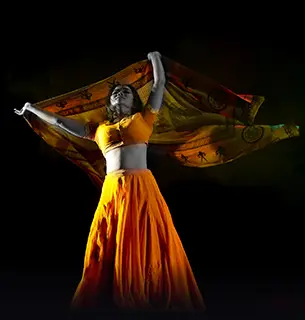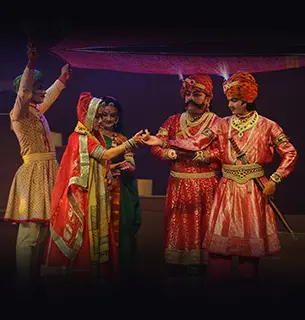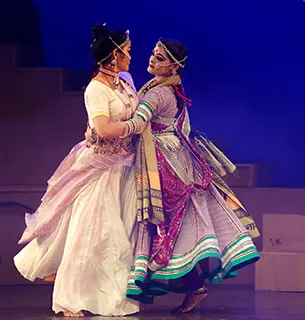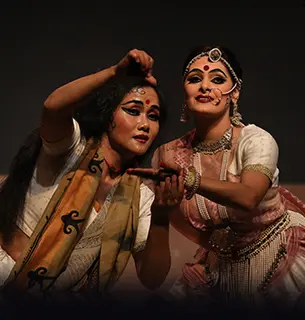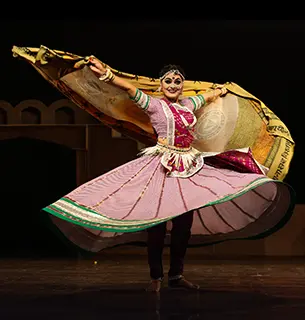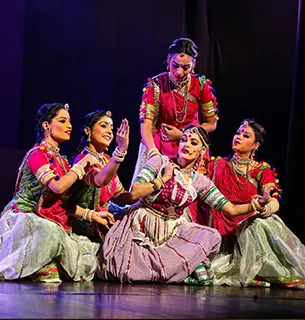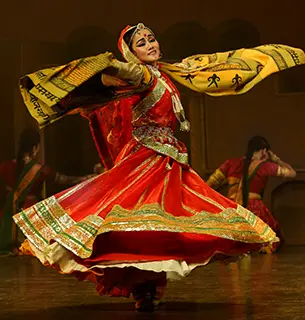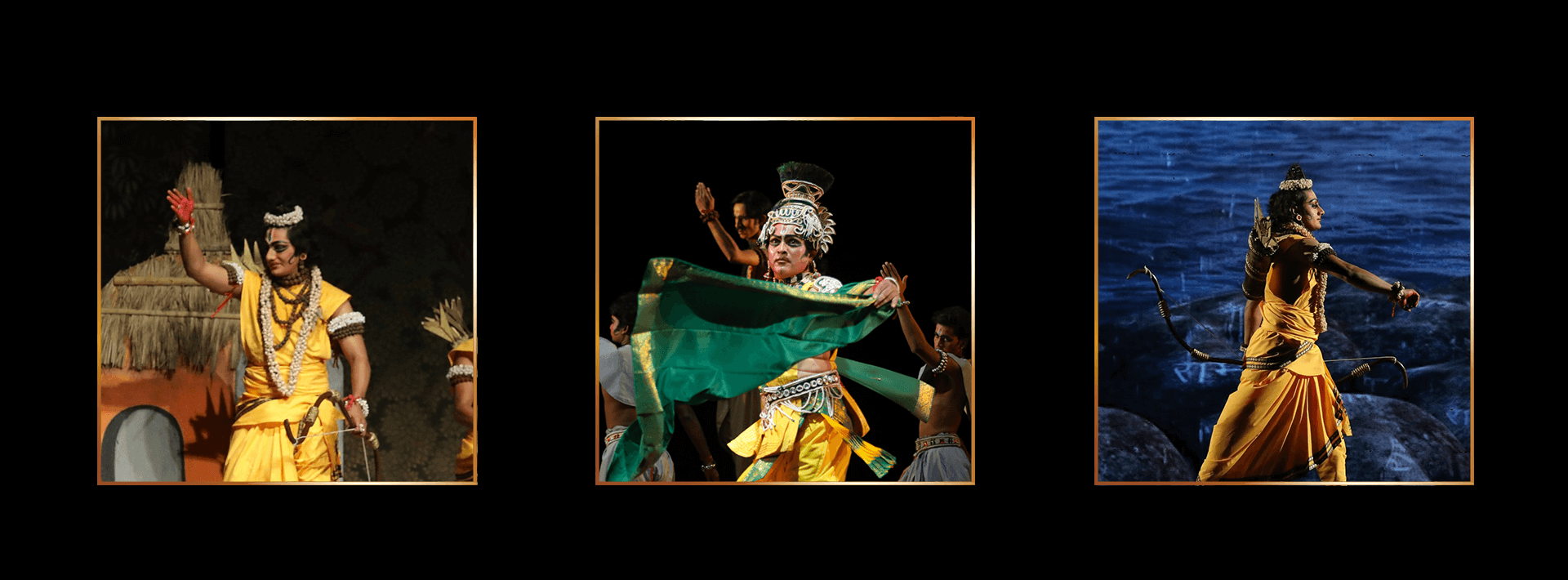
About Flagship Productions
The Kendra has ambitiously produced multiple dance-dramas over the years. These large-scale spectacles are based on Hindu mythology, Sanskrit and literary classics, historical characters, and varied contemporary themes.
The frontrunners of these memorable ballets are the Kendra’s flagship productions – Shri Ram, Shri Krishna, and Meera that are presented almost every year to date. The audience continues to marvel at these larger-than-life productions that explore and present Indian culture’s legendary epic and folk themes.
The Ramayana’s stories spread across South and Southeast Asia through various forms like art, music, and performances. While the main plot is similar to the original Valmiki Ramayana, each version has its own nuances. Deeply ingrained in Indian culture, the Epic is celebrated through Hindu practices, paintings, sculptures, and textiles. It has also been part of storytelling traditions through folk music and performances and is popular in media adaptations like Amar Chitra Katha comics and TV shows.
However, an exceptional theatrical performance in New Delhi stands out in contemporary society. The internationally acclaimed dance drama titled “Shri Ram”, presented by Shriram Bharatiya Kala Kendra
An Annual Cultural Pilgrimage
A prominent highlight of India’s cultural calendar, this spectacular production unfolds the timeless epic of the Ramayana, from Lord Ram’s birth to his coronation, in an enthralling 2-hour and 15-minute performance.
New Delhi’s cultural heartbeat comes alive with every celebratory season. Shri Ram has become an annual cultural pilgrimage for lakhs, embodying over seven decades of tradition to which many return year after year. It commences with the first Sharadiya Navratri and lasts 24 to 25 days. It is not just a performance but a journey through time, connecting audiences to India’s epic storytelling tradition.
Shri Ram was conceived by SBKK’s visionary founder, Sumitra Charat Ram, whose cultural journey and academic pursuits at Banaras Hindu University inspired the production. Under the artistic guidance of her daughter and SBKK’s Chairperson, Padmashri Smt. Shobha Deepak Singh, the show has evolved over the years while preserving its essence. Each year, the staging integrates and improves contemporary and traditional choreography, innovative stage technology, and traditional Indian craftsmanship, creating a visual and emotional work of outstanding Artistry.
A Legacy of Indian Cultural Heritage and Values
Initially enriched by the contributions of the former National Poet Ramdhari Singh ‘Dinkar,’ choreography by legends such as Guru Gopinath Bhagwan Das Verma, Narendra Sharma and music by Sr. Dagar Brother, Barun Gupta, the production has grown to incorporate freshly recorded music, lyrics and interactive elements. Shobha Deepak Singh has continued to refine the presentation by adding voice-overs to dialogues from celebrated actors like Manohar Singh, enhancing the audience’s immersive experience. Her re-work and re-design of the sets, animations, costumes, and jewellery reflects a deep appreciation for Indian craftsmanship, blending tradition with trendiness.
“Shri Ram” is more than just a retelling of the Ramayana. It is an educational tool, a common connection between generations, and a tribute to Indian talent in Indian crafts, dance, music, and design. Each year, it is deeply gratifying to see how audiences become a part of this narrative, connecting ancient teachings with contemporary relevance.
Since its debut in 1957, the performance has captivated over 15 Lac spectators and earned accolades from nearly every Indian President and Prime Minister. Kendra’s interpretation of the Ramayana stands out for its distinctive aspects, including a Ramcharitmanas Manuscript featuring the signatures of India’s Presidents and Prime Ministers dating back to 1957. This production, inaugurated annually by prominent figures, symbolises the production’s role as a custodian of India’s cultural heritage.
Cultural and International Recognition
The production has travelled across India and abroad, receiving honours for its universal appeal. It has been recognized as the best-ever rendition of the Ramayana by the Ayodhya Shodh Sansthan and was specially invited to perform at Ayodhya during the inauguration of the Ram Mandir. International awards in culturally important regions like Yogyakarta, Indonesia, further emphasise its global relevance. The show has also been performed in 35 Countries Worldwide
Beyond the aesthetic spectacle, “Shri Ram” reflects the values of duty, righteousness, and devotion, resonating deeply with contemporary audiences. By highlighting the core essence of human struggles—brotherhood, unconditional love, and respect for elders—the production offers moral teachings that go beyond time.
An Immersive Cultural Experience
Crafted in SBKK’s distinctive dance-drama style, “Shri Ram” blends classical and folk-dance forms, including Bharatanatyam, Kalariyapattu, Mayurbhanj Chau, and North Indian folk traditions, all set to original Hindustani classical music. The production engages the audience with interactive storytelling elements, engaging them in a divine and spiritual experience of being active participants in Lord Ram’s journey. While grounded in the ancient era of Satyug, the themes and challenges remain strikingly relevant to today’s world – Kalyug. Its narrative is timeless, and the lessons of the Ramayana are relevant for today’s society, offering wisdom and insight that guide us in facing modern challenges
A Tradition of Excellence
Over the past six decades, Shri Ram has consistently evolved, incorporating new elements while preserving the admiration and artistic excellence that have made it a National Treasure.
This dance drama by Shriram Bharatiya Kala Kendra portrays Lord Krishna’s life, from birth to liberation. Rooted in the Mahabharata, it vividly depicts his character through narrative storytelling, mythological references, and soul-stirring music. More than a retelling, it offers a spiritual journey, inviting the audience to connect with Krishna’s story. This production promises an immersive experience combining Indian dance, drama, and mythology.
Krishna defies categorization: he embodies wisdom, valour, tenderness, and foresight. This dance drama highlights his inspiring personality and complex inner life. As a child, he is playful; as a youth, beloved by Radha and the Gopis; as an adult statesman, he guides Arjuna on the battlefield. Each role reflects his divine qualities and connection with people, presenting his unique divinity and humanity.
Krishna’s life story is rich with symbols and lessons central to Indian philosophy. It embodies love, sacrifice, bravery, compassion, and enlightenment. This drama depicts Krishna’s life as a metaphor for the soul’s journey, inspiring the audience to find meaning amid life’s challenges and leaving viewers with reflections on truth, love, and moral wisdom.
Krishna in the Mahabharata:The Mahabharata, one of the longest epics in world literature, presents Krishna as both a mortal figure and a divine presence. Key chapters that shape Krishna’s role and character include:
The Mediator: Krishna’s efforts to prevent the war between the Pandavas and Kauravas emphasize his role as a strategist and peacemaker. Despite offering a compromise, Duryodhana’s arrogance leads to conflict, illustrating the inevitability of war when egos and injustices prevail. Krishna’s mission teaches the value of peace and the repercussions of failing to achieve it.
Bhagavad Gita: The Bhagavad Gita presents Krishna’s conversation with Arjuna on the battlefield of Kurukshetra. Krishna addresses duty (dharma), selfless action (karma), devotion (bhakti), and knowledge (jnana), urging Arjuna to rise above attachments and fulfil his role. The Gita provides timeless guidance on life, ethics, and spirituality, emphasizing that true fulfilment arises from fulfilling one’s duties with integrity and surrendering to a higher purpose.
Krishna’s Liberation: Krishna consoles the women after the war, reflecting his compassion and empathy. His departure to the divine realm marks the closure of his earthly journey. In this drama, Krishna reveals his universal form, Vishvarupa, highlighting his transcendental nature and interconnectedness with all creation. This moment underscores Krishna’s identity as both an earthly guide and a universal soul.
Krishna’s character embodies a philosopher, diplomat, friend, guide, and divine avatar, influencing those around him and shaping the epic’s narrative.
The Artistic Blend of Dance and Mythology The production blends Indian classical and folk dance, with each scene choreographed to express Krishna’s narrative, from childhood exuberance to the profound insights of the Bhagavad Gita. Costumes, jewelry, and animations enhance the stage, while the musical score merges classical and folk elements for a unified auditory experience. Dance and storytelling interweave to vividly represent mythology, resonating with contemporary culture.
SBKK’s ‘Shri Krishna’ presents an extraordinary narrative of one of Hindu mythology’s most revered figures. Attendees seeking artistic beauty, spiritual depth, or cultural richness will discover a multifaceted experience that surpasses time and inspires across generations.
Meera’s legacy inspires those confronted with adversity, providing solace and a vision of liberation through her poetry. The reinterpretation of Meera’s persona in this dance-drama seeks to explore and question the role of women in a predominantly male society, striving for authenticity in its portrayal. The production draws from the vibrancyof Rajasthani and Gujarati folk dances, offeringinsightsinto Meera’sdevotion to Lord Krishna, with a soundtrack inspired by the works of Komal Kothari, weaving her story through dance and music into a narrative of varied emotions.
Meera stands as a legendary figure among the saint poets of the nation, transforming the barren deserts of Rajasthan with her lyrical abilities and illuminating the paths of countless individuals in search of spirituality. Her beliefsare immortalized through her poetic expressions of life’s upheavals, offering a glimpse into her own experiences. Meera’s life, characteristic of the struggles faced by many women, continues to echo centuries later, her name a symbol of resilience against the feudal system of her time.
Her journeywas marked by spreadingthe message of freedom and encouraging deeper, personal enlightenment through her vibrant poetry. Meera’s versesstand as proofof the strength inherent in womanhood, rejecting materialism in favour of spiritual enlightenment. Forsaking the comforts of royalty, she shattered the constraints of tradition and emerged as anideal of emancipation, her joyous dance and music a celebration of liberated femininity.
Meera’s survival and defiance of feudal and patriarchal restrictionshighlight her importance in cultural and aesthetic studies. Initially perceived as lacking creative challenge, the extensive research by Smt.Shobha Deepak Singh., Jayamala Aiyer, Keshav Kothari, and the narrative voice revealed the symbolic significance of the miracles in Meera’s life as metaphors for the challenges overcome by women. With Direction & Costumes by Smt.Shobha Deepak Singh,Shashidharan Nair& Papiha Desai’s Choreography and Music by Shubha Mudgal, this reinterpretation celebrates Meera as a passionate activist and continues to inspire and enlighten. The challenge of interpreting her life through dance-drama unveils an abundance of viewpoints, revealing the journey of this rebellious saint poetess.










